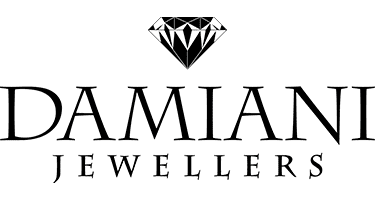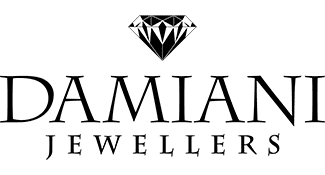1. How much should I spend on an engagement ring?
2. What karat gold should I choose?
3. What type of gold does Damiani Jewellers sell?
4. Other than gold, what types of precious and innovative metals does Damiani Jewellers sell?
Precious Metals
Silver
= .925 or .800 pure silver
Silver will tarnish when exposed with the air. It is a natural magnet for sulphur, so it turns black. Proper care, as well as cleaning and polishing, is needed to bring it back to original lustre. Some silver is plated with rhodium to avoid oxidation. However, if the item is scratched, it will start to oxidize.
Platinum
= .950 or .800 pure platinum
Platinum is the rarest and heaviest of the precious metals. Platinum is purer than typical gold jewellery and more expensive. It is 1.7 times heavier than gold. It is more difficult to work with, but has better durability.
It is a dense, malleable metal that is naturally white in colour. The white colour will not change over time. Platinum is 100% hypoallergenic. A platinum wedding band will scratch but can easily be restored to its natural form without difficulty.
Palladium
Palladium is a more affordable alternative to platinum. It is less dense than platinum and weighs about the same as 9kt gold. It is tough, hardwearing, and 100% hypoallergenic. It is also a naturally white metal that will not change colour over time. A palladium wedding band will scratch but can easily be restored to its natural form without difficulty.
Innovative Metals
Cobalt
Cobalt is a hard, hypoallergenic metal with a naturally metallic, light grey colour. Cobalt is 4 times harder than Platinum, 5 times harder than gold, completely shatterproof, and will never chip or crack. It can, however, be very difficult to remove if there is an emergency.
Tungsten Carbide
Tungsten carbide is a tremendously heavy and hard metal. Its surface is extremely scratch resistant, which makes it one of the most popular innovative metals available. Although it is a hard metal, it is also very brittle. If dropped on a hard surface, it can shatter or chip. It is not a hypoallergenic metal because it contains traces of nickel.
Over time the metal will oxidize, causing discolouration. Discolouration can also be caused by perfume or chlorine. Most of the time, this can be removed by polishing.
It will rarely scratch and cannot be refinished.
Titanium
Titanium is a very light, lustrous metal with a grey colour. By the touch and feel, titanium seems like a very weak, “plastic” like metal, but actually has the highest strength-to-weight ratio of any metal. It is 100% hypoallergenic. It can scratch, but can be easily restored to its natural form without difficulty.
Stainless Steel
It is rust proof steel. It is the cheapest metal to buy and is mostly used for men’s fashion rings and jewellery.
5. What kinds of pearls do you sell?
Damiani Jewellers has a large selection of pearls including:
Cultured Pearls — are grown in pearl farms. The mollusks are raised until they are old enough to accept the mother-of-pearl bead nucleus. Through a delicate surgical procedure, the technician implants the bead, and then the mollusks are returned to the water and cared for while the pearl forms. Not all produce a pearl; and not all the pearls are high quality. Over 10,000 pearls may be sorted before a 16” single strand of beautifully matched pearls is assembled.
Saltwater Pearls — these include the Akoya cultured pearls grown in Japanese and Chinese waters. They range in size from 2mm (tiny) to 10mm (rare) and are usually white or cream in colour and round in shape. Australia, Indonesia, and the Philippines produce the South Sea pearl – the largest of all the pearls. They range in size from 9mm to 20mm and can be naturally white, cream, or golden in colour. Tahitian pearls are interestingly not exclusively from Tahiti. They are grown in several of the islands of French Polynesia, including Tahiti. Their typical sizes range from 8mm to 16mm. These naturally coloured pearls are collectively called black pearls, but their colours include grey, blue, green, and purple.
Freshwater Pearls — these pearls are grown in freshwater lakes, rivers, and ponds predominately in China. Although many are white and resemble the Akoya cultured pearls in shape and size, they can also be produced in various shapes and in an array of pastel colours. Many freshwater pearls do not have a bead nucleus — only a piece of tissue — resulting in a pearl with thicker nacre than the Akoya.
Galatea Pearl - is the world’s only cultured pearl with a brilliant coloured stone centre, carved by hand to let the colour shine through. It is rare and is the result of a unique culturing process, a patented procedure that begins with a bead nucleus of R.C. turquoise, synthetic red coral, amethyst or citrine. The bead nucleus is inserted into the oyster and the mollusc is gently placed back into the sea, where it will coat the bead with nacre (pearl) over many months. After harvesting, these rare cultured pearls are carved by hand. This sculpting of the pearl allows the colour to be seen beneath the nacre. They are set into jewellery, with or without a Diamond in a Pearl setting.
6. What value will my diamond retain in the future?
7. Do you sell Canadian diamonds?
Damiani Jewellers has a large selection of Canadian diamonds, and only sells ethically mined diamonds. In recent years, Canada has come to the forefront of the international diamond industry. Canada has become the third largest supplier of rough in the world and will soon occupy the top spot as more and more Canadian diamond mines come online. Recognizing the benefits to the Canadian marketplace and, in particular, to the Canadian Diamond consumer, Damiani Jewellers has forged a unique marketing alliance with premiere cutters and polishers of certified Canadian diamonds from the Northwest Territories and from Sudbury’s own Victor mine.
The cutting works of the Victor Mine located in Sudbury uses only the most modern polishing equipment and technology in its Canadian manufacturing facilities. A team of master cutters and polishers produce certified Ontario diamonds from 0.30ct to 3.0ct in better qualities. Each diamond polished at the plant is meticulously checked and monitored by the latest computer technology. Only then is it given to the Government of Ontario for certification.
The graded Canadian Diamond with its serial number laser-inscribed on its girdle and with an accompanying “Certificate of Authenticity” is finally ready to be shipped directly from the cutting and polishing factory to Damiani Jewellers. We invite you to search our Rapnet database, which will give you detailed information including the prices of each stone. We are confident that you will appreciate our unique offering of Canadian diamonds, but what sets us apart is our knowledgeable staff and full service facility where you can see our loose diamonds and try on hundreds of different rings.

8. What are the 5Cs of a diamond?
Cut
Cut refers not to the shape of the diamond, but to the angles, proportions and faceting arrangements of the stone. It is perhaps the most important of the 5Cs because it is what releases the diamond's brilliance. A well-cut diamond will internally reflect light from one facet to another and disperse and reflect it through the top of the stone. Diamonds that are cut too deep or too shallow lose or leak light through the side or bottom, resulting in less brilliance.
The shape of a diamond is its outline. Common shapes for a diamond are round, emerald, oval, princess, radiant, pear, marquise and heart. The faceting arrangement, along with the outline of the diamond, results in the diamond's visual brilliance.


Colour
Colour refers to the degree to which a diamond is colourless. Colour in a diamond is the result of traces of other elements, which mix with carbon during the diamond's formation. White diamonds are colour graded on a scale that begins with "D", which indicates total colourlessness, progressing down the alphabet for lower qualities. Diamonds tinged with yellow or brown are less desirable. Diamonds of vivid colours such as canary yellow, red, pink, blue and green are known as Fancy Diamonds. They are rare and highly valued.

Clarity
Clarity is an indication of a diamond's purity. In all diamonds, except the most rare, tiny traces of non-crystalized carbon (the element from which a diamond is formed) can be trapped during the crystallization process. These internal “inclusions” appear as tiny crystals, clouds or feathers. The fewer the inclusions present, the more valuable the diamond. However, the presence of some inclusions does not diminish the diamond's beauty or endanger its durability. Most cannot be seen without powerful magnification.
Clarity is based on the quantity, size, position, nature, colour and relief of inclusions in a diamond. There are 10 clarity grades, where each grade represents a range. A trained grader, using 10-power magnification, determines clarity.
The scale for grading diamond clarity is:
- Flawless – These diamonds do not have any inclusions and are considered to be perfect.
- Internally Flawless – These diamonds may have very minor blemishes on the outside surface of the stone.
- VVS1, VVS2 – These diamonds have very, very small inclusions.
- VS1, VS2 – These diamonds have very small inclusions.
- SI1, SI2, SI3 – These diamonds have small inclusions.
- I1, I2, I3 – These diamonds have flaws which can be seen with the human eye.

Carat Weight
Carat weight is the gemologist's universal measurement of a diamond weight (not how big it is) and is the easiest of the 5Cs to determine.
Diamonds are weighed when they are loose or free from any mounting or setting. A carat weighs 0.02 grams or 1/142 of an ounce. And one carat is made up of 100 units called points. Therefore, a diamond of 75 points weighs 3/4 of a carat, and 50 points weighs 1/2 of a carat. It is important to know that two diamonds of equal weight can have very different appearances because of their cut, and different values because quality is still determined by cut, colour and clarity.
Remember, bigger isn’t necessarily better. A large carat weight diamond can also be cut well, but have poor colour and clarity, which again will reduce the price compared to a cleaner smaller diamond.
Certificate
While a diamond can be the ultimate symbol of love, it also represents an investment in time, energy and money. You need to feel confident in the integrity of your stone. Many jewellery consumers are now relying on a more precise document that evaluates the true value of gems — the diamond certificate.
A diamond certificate is a printed report based on a gemological analysis of a specific stone. It is prepared in an independent laboratory by certified gemologists.
The certificate will state your diamond’s colour, clarity, cut, carat weight. It will describe the diamond’s shape, measurements, table and depth percentages and grade the polish and symmetry. It should also comment on characteristics like fluorescence, internal graining and imperfections. Often the certificate may estimate the replacement value of the stone for insurance purposes. Finally, the certificate should include a detailed sketch of the diamond.
The most premium certificate in the diamond market is GIA and therefore GIA is priced more than other certificates. Other certificate companies are also equally respected and rank the following – HRD, IGI, EGL, etc.
9. What is so special about FireCushion® Diamonds?
Damiani Jewellers is the only retailer in Ontario that offers the beautiful, patent-pending FireCushion® Diamond.
It is classified as cushion brilliant, not modified brilliant. GIA grades it as EX/EX polish and symmetry. It is so extraordinarily rare that less than one out of every thousand cushions in the world is classified as EX/EX cushion brilliant.
Typical cushion diamonds lack brilliance and have deep bellies, causing you to pay for weight you cannot see. However, the FireCushion® diamond uses precise cutting techniques for a 95% light return. Also, you get a significant size advantage –it is 15% larger than typical cushions of the same weight.
FireCushion® diamonds are more square, not rectangular. The squarer the diamond, the less dead spots are found in the centre of the stone.
It is similar to a round diamond with matching brilliance and beauty, but is less expensive than a round of the same weight.





